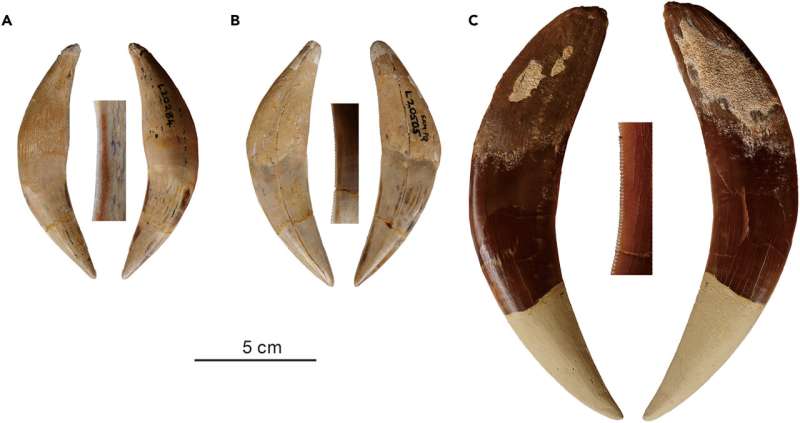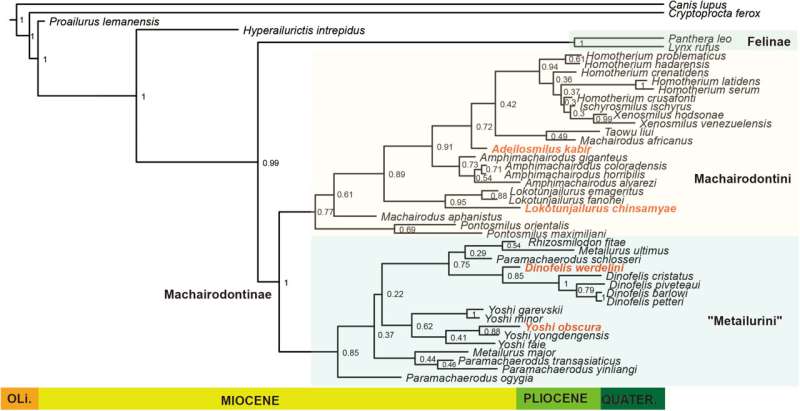Sabertooth cats make up a diverse group of long-toothed predators that roamed Africa around 6–7 million years ago, around the time that hominins—the group that includes modern humans—began to evolve.
By examining one of the largest global Pliocene collections of fossils in Langebaanweg, north of Cape Town in South Africa, researchers presented two new sabertooth species and the first family tree of the region’s ancient sabertooths on July 20 in the journal iScience. Their results suggest that the distribution of sabertooths throughout ancient Africa might have been different than previously assumed, and the study provides important information about Africa’s paleoenvironment.
“The known material of sabertooths from Langebaanweg was relatively poor, and the importance of these sabertoothed cats has not been properly recognized,” says senior author Alberto Valenciano, a paleontologist at Complutense University. “Our phylogenetic analysis is the first one to take Langebaanweg species into consideration.”
The study described a total of four species. Two of these species, Dinofelis werdelini and Lokotunjailurus chimsamyae, were previously unknown. Dinofelis sabertooths are globally distributed, and their fossils have been found in Africa, China, Europe, and North America. The researchers were expecting to identify a new Dinofelis species from Langebaanweg based on prior research. However, Lokotunjailurus has only ever been identified in Kenya and Chad before this analysis. This suggests that they may have been distributed all throughout Africa between 5–7 million years ago.
Valenciano was a postdoctoral fellow at the Iziko Museums of South Africa, which houses all the sabertooth fossils that were analyzed in this study. A team of colleagues from China, South Africa, and Spain put the final project together. To construct a family tree, the researchers classified the physical traits of each sabertooth species—such as presence or absence of teeth, jaw and skull shape, and tooth structure—and coded this information into a matrix that could determine how closely related each sabertooth was to its evolutionary cousins.

The resulting population composition of Langebaanweg sabertooths (Machairodontini, Metailurini, and Feline) reflects the increasing global temperatures and environmental changes of the Pliocene epoch. For instance, the presence of Machairodontini cats, which are larger in size and more adapted to running at high speeds, suggests that there were open grassland environments at Langebaanweg.
However, the presence of the Metailurini cats suggests that there were also more covered environments, such as forests. While the fact that researchers found both Metailurine and Machairodonti species suggests that Langebaanweg contained a mixture of forest and grassland 5.2 million years ago, the high proportion of Machairodonti species compared with other fossil localities from Eurasia and Africa confirm that southern Africa was transitioning toward more open grasslands during this period.
“The continuous aridification throughout the Mio-Pliocene, with the spread of open environments, could be an important trigger on the bipedalism of hominids,” the authors write. “The sabertooth guild in Langebaanweg and its environmental and paleobiogeographic implications provide background for future discussion on hominid origination and evolution.”
Interestingly, the researchers also note that the composition of sabertooths in Langebaanweg closely mirrors that of Yuanmou, China. Yuanmou’s Longchuansmilus sabertooths might even have a close evolutionary relationship with Africa’s Lokotunjailurus species.

“This suggests that the ancient environment of the two regions was similar or that there was a potential migration route between the Langebaanweg and Yuanmou,” says first author Qigao Jiangzuo, a paleontologist at Peking University.
More fossil evidence could help paleontologists understand exactly how these two sites are related. “The two new sabertooths are only an example of the numerous unpublished fossils from Langebaanweg housed at Iziko in the Cenozoic Collections,” says Romala Govender, a curator and paleontologist at the Iziko Museums in South Africa. “This brings to the fore the need for new and detailed studies of Langebaanweg fauna.”
More information:
Alberto Valenciano, Langebaanweg’s sabertooth guild reveals an African Pliocene evolutionary hotspot for sabertooths (Carnivora; Felidae), iScience (2023). DOI: 10.1016/j.isci.2023.107212. www.cell.com/iscience/fulltext … 2589-0042(23)01289-0
Provided by
Cell Press
Citation:
Paleontologists identify two new species of sabertooth cat (2023, July 20)
retrieved 26 July 2023
from https://phys.org/news/2023-07-paleontologists-species-sabertooth-cat.html
This document is subject to copyright. Apart from any fair dealing for the purpose of private study or research, no
part may be reproduced without the written permission. The content is provided for information purposes only.

